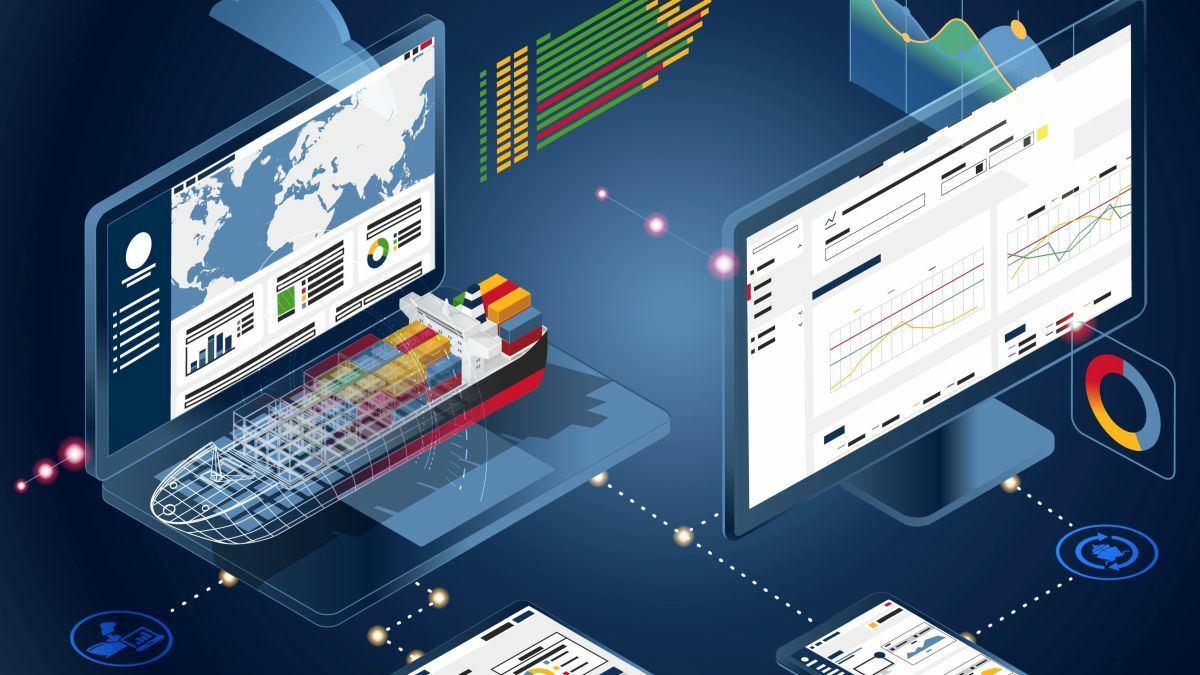Predictive Insights
Predictive insights within the shipping industry are the use of data analytics as well as advanced algorithms that forecast and anticipate different aspects of shipping. It is the use of the latest data and historical information to create informed forecasts and improve the efficiency of shipping processes. Big data analytics plays a vital role in enabling these insights through analysing and processing huge amounts of data to find patterns or trends, as well as relationships.
Here are two ways that big data analytics are impacting predictive insight in shipping.
Route Optimization
Big data analytics enables shipping companies to optimize their shipping routes by analyzing various factors, including traffic patterns and weather conditions, consumption of fuel, and delivery time windows. By integrating real-time information from multiple sources, such as GPS as well as weather APIs, as well as traffic sensors, firms can adapt their routes in real-time to prevent delays, cut costs for fuel, and increase the overall efficiency of delivery. This helps improve customer satisfaction by ensuring prompt and efficient deliveries. Optimization of routes is particularly important for companies operating online that deal with large-scale deliveries because big data could provide companies with information about the most cost-effective method to deliver large quantities of packages.
Supply Chain Visibility
Big data analytics allow shippers to have instant insight into their supply chain through capturing and analyzing data from a variety of points of contact, such as warehouses, suppliers, as well as transportation networks, and even final destinations. This increased visibility allows companies to pinpoint bottlenecks, keep track of the status of their shipment, and take action to prevent delays or disruptions. This also facilitates more efficient coordination among the various stakeholders within the supply chain, which leads to improved efficiency and better customer service.
Real-time Monitoring and Tracking
Real-time monitoring of packages or tracking is the capability to track the movements and position of parcels in real-time during the entire delivery process. It is achieved by utilizing various technologies like barcodes, RFID tags GPS scanners, as well as barcodes to collect and transmit information regarding the status of packages at various points along the route. The data is then provided to the customer as well as shipping companies, allowing them to keep track of and monitor the delivery of their parcels in real-time. Big data analytics play an essential role in real-time tracking of packages through analyzing and processing the huge amount of tracking information generated during the process of shipping. This is how Big Data Analytics can contribute to the monitoring of packages in real-time:
Data Processing
Big data analytics manages the large volume, speed, and range of tracking data that is generated through packages being sent. It organizes and processes the information and extracts pertinent details such as the package’s ID, address, time, timestamp, as well as status updates. By comparing the real-time tracking data with benchmarks or thresholds that have been set, it will identify any potential problems or deviations, as package diverting and missed pickups, or delivery issues. This allows shipping businesses to take proactive steps and address issues quickly.
Predictive Analysis
By studying historical tracking data, and taking into account external factors like traffic patterns, weather conditions and performance of the carrier Big data analytics could give you insights from a predictive perspective. It could anticipate delays or problems in the process of shipping and give estimated delivery times more precisely.
Data Visualization and Reporting
Big data analytics are able to provide tracking data in an intuitive and visually appealing way. With interactive reports and dashboards shipping firms and customers have access to real-time tracking information and track the progress of their shipment and keep track of important metrics like the delivery time or average transit time.
Utilizing big data analysis, real-time tracking of packages provides greater transparency, improved efficiency in operations, and increased satisfaction of customers. It enables shipping companies to monitor packages, deal with potential problems quickly and give customers updated and precise information on their packages throughout their transportation process.
Demand Forecasting and Inventory Optimization
Big data analytics play an essential role in forecasting demand and optimizing inventory. It utilizes massive volumes of data to uncover insights, make precise predictions, and optimize the level of inventory. Through the analysis of the past statistics on sales and customer behaviours, along with market trends and other external factors, big data analytics allow retailers to predict demand more accurately. This allows them to optimize their levels of inventory, minimize inventory shortages, prevent overstocking, and satisfy customer demand efficiently. In addition, big data analytics incorporates live data from multiple sources that allows retailers to alter levels of inventory based on changes in patterns of demand and to make the right decisions based on data. Utilizing machine learning as well as predictive analytics, big data analytics detects trends, seasonality, and anomalies to create precise demand forecasts, identify possible stockout, and suggest the best reorder quantity. In the end, big data analytics enables retailers to maximize inventory and supply chain efficiency, reduce costs, and improve customer satisfaction.
Using Machine Learning to Optimize the Supply Chain
Machine learning plays an important part in enhancing the supply chain through the use of data-driven insights. For instance, machine learning algorithms look at massive amounts of data as well as external influences to give accurate predictions and find patterns that can be used to make better strategic decisions. This aids in choosing reliable suppliers and managing relationships with suppliers, and reducing the risk of supply chain disruptions. Supply chain managers can take proactive steps to manage risk by using machine learning. By identifying patterns, anomalies, or anomalies in data, models of machine learning can anticipate and predict potential problems or risks within the supply chain. Supply chain managers can implement contingency plans proactively to evaluate alternative sourcing options and limit the effects of disruptions.
The Function of Big Data Analytics in Improving Shipping and Supply Chain Efficiency

Predictive Insights
Predictive insight in the shipping industry is the use of data analytics as well as advanced algorithms to predict and anticipate the various aspects of shipping. It involves using historical and real-time information to develop informed predictions and improve the efficiency of shipping processes. Big data analytics play a vital role in enabling the ability to make predictions by processing and analysis of huge amounts of data to find patterns, as well as trends and relationships.
Here are some ways that big data analytics are affecting predictive information in the industry of shipping industry.
Route Optimization
Big data analytics enables shipping companies to optimize their shipping routes by analyzing various factors like traffic patterns and weather conditions, consumption of fuel, and delivery times. By integrating real-time information from a variety of sources, such as GPS and weather APIs and sensors for traffic, companies can adapt their routes in real-time to avoid delays, decrease fuel expenses, and increase the efficiency of delivery overall. This improves customer satisfaction by providing timely and cost-effective delivery. Route optimization is crucial for online retailers that deal with large-scale deliveries because big data can help companies determine the most efficient method of shipping large quantities of packages.
Supply Chain Visibility
Big data analytics allow shipping firms to get instant access to their supply chain by collecting and analyzing information from multiple sources, including warehouses, suppliers, transport networks, warehouses, and finally, the final destination. This increased visibility allows companies to spot bottlenecks, monitor the status of their shipment, and deal with any delays or disruptions. It also allows more efficient coordination among the various stakeholders within the chain of supply, which leads to greater efficiency and improved customer service.
Real-time Monitoring and Tracking
Real-time monitoring of packages or tracking is the capability to track the movements and position of parcels in real-time during the entire delivery process. It involves the use of various methods like barcodes, RFID tags GPS scanners, as well as barcodes to record and send information about the status of packages at various points along the route. The information is accessible to both customers and shipping companies, enabling them to keep track of and monitor the delivery of their parcels in real-time. Big data analytics play an essential role in monitoring packages in real time by analysing and processing the huge amount of tracking information generated during the process of shipping. This is how Big Data Analytics can contribute to the monitoring of packages in real-time:
Data Processing
Big data analytics manages the huge volume, speed, and range of tracking data gathered through packages being sent. It analyzes and organizes the data, removing relevant details like package ID, address, as well as timestamps, status, and updates. By comparing the real-time tracking data against predefined benchmarks or thresholds and identifying any possible issues or deviations, for example, package diversion and missed pickup, or delivery issues. This allows shipping businesses to take proactive steps and solve issues swiftly.
Predictive Analysis
Through analyzing the historical tracker data and analyzing external factors like the weather, patterns of traffic and the performance of carriers Big data analytics can give you insights from a predictive perspective. It could anticipate delays or problems during the shipping process and give estimated times for delivery more precisely.
Data Visualization and Reporting
Big data analytics can display tracking information in a simple and visually appealing way. By using interactive dashboards or reports, shipping firms and their customers can access real-time tracking updates as well as track the progress of the shipment and keep track of crucial metrics like the delivery time or average transit time.
Utilizing big data analysis, real-time tracking of packages provides greater transparency, improved efficiency of operations, and enhanced customer satisfaction. It enables shipping companies to monitor packages, deal with potential problems quickly and provide customers with current and accurate information regarding their parcels throughout the entire shipping process.
Demand Forecasting and Inventory Optimization
Big data analytics play crucial roles in forecasting demand and optimizing inventory. It utilizes massive volumes of data to uncover insights, create accurate forecasts, and improve the level of inventory. By studying the past statistics on sales and customer behaviour as well as market trends and other external factors, big data analytics allows retailers to predict demand more precisely. This can help optimize the amount of inventory, decrease inventory shortages, prevent overstocking, and satisfy customer demand efficiently. Furthermore, big data analytics integrates live data from various sources, which allows retailers to adjust the amount of inventory they have to adapt to changing patterns of demand and to make decisions based on data. Through the use of machine-learning and predictive algorithms, big data analytics detects trends, seasonality, and anomalies to create accurate forecasts of demand, spot the possibility of stock shortages, and recommend the best reorder quantity. In general, big data analytics allows retailers to maximize inventory and improve the efficiency of supply chains, reduce costs, and improve customer satisfaction.
Leveraging Machine Learning for Supply Chain Optimization
Machine learning plays a vital part in optimizing the supply chain, utilizing data-driven insights. For instance, machine learning algorithms analyze tons of data and external variables to make precise predictions and find patterns to aid in making better strategic decisions. This assists in selecting reliable suppliers, establishing relationships with suppliers, and reducing the risks associated with the supply chain. Supply chain managers are also able to actively manage risks through the use of machine learning. By identifying patterns, anomalies, or anomalies in data, models of machine learning can anticipate and predict potential interruptions or risks that could arise in the supply chain. Supply chain managers can proactively implement contingency plans and evaluate alternative sources of supply, and reduce the impact of disruptions.




